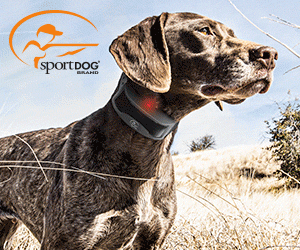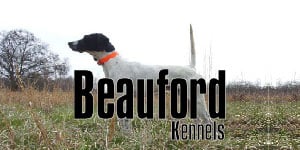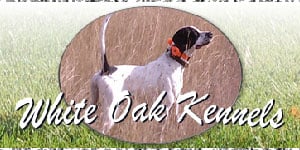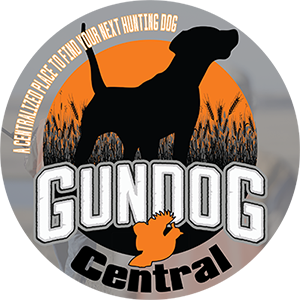Border Terrier - Started Dogs
Find Border Terriers for sale on this page
For more information about the Border Terrier Click hereThe Border Terrier is naturally bred to hunt. Alert and good-natured, he was originally bred for fox hunting. The terrier would drive foxes from their hideouts and into the open for the foxhounds to chase.
Today, the Border Terrier still has a powerful hunting drive and energy level plus he is a wonderful companion who is loyal and affectionate.
History of the Border Terrier
We can trace the ancestry of the Border Terrier to the Cheviot Hills in Great Britain. In the 19th and early 20th century, the Cheviot Hills, which border England and Scotland, were full of hill foxes. To hunt these foxes, shepherds and farmers needed a terrier with a powerful hunting drive and energy to keep up with hunters on horseback.
Besides keeping up with the horses, the farmers and shepherds needed a terrier with enough sense to keep out of trouble with horses. They also wanted a compact terrier to follow a fox to ground and have a weather-resistant coat to withstand bone-soaking rains.
At the time, such a terrier was common in every shepherd, farmer, or sportsmans home in the area. The Border Terrier is one of the oldest terriers. In fact, border farmers have been using Border Terriers to hunt foxes since 1869.
Farmers and shepherds around the Cheviot Hills chose the Border Terrier because it has a long, narrow, and flexible body. As such, it could squeeze through narrow burrows to reach the quarry, at which point they would roust them out of their dens.
Contrary to popular belief, the Border Terrier never ran with the foxhound. Instead, they followed the hunters and border farmers, who were on horseback, ready to go to ground and chase foxes to the open.
In the late 19th century, the Border Terrier participated in several dog shows in Northumberland. In 1920, the British Kennel Club recognized the Border Terrier dog breed and formed the Border Terrier Club.
A decade after the British Kennel Club recognized the Border Terrier, the American Kennel Club recognized the dog breed. Although the Border Terrier has never reached ring show popularity like other terriers, its still built to do its job.
Border Terrier Appearance
The male Border Terrier is 11 inches tall at the shoulders, while the female is 10 inches. The males weight range is 13 to 15 pounds, and for the female, 11 to 14 pounds. His head is distinctive, with dark hazel eyes that are full of intelligence and fire.
Moderate in size, the eyes are neither beady or small. When it comes to the ears, theyre of moderate thickness and V-shaped. While not set high on the head, they drop forward close to the Border Terriers cheeks. Speaking of the cheeks, theyre slightly full while the muzzle is well filled and short.
Its dark with a few short whiskers and a black nose. Teeth are strong with a scissors bite but are large for the dogs size. The neck is long enough and muscular, giving the dog a well-balanced appearance. It widens into the shoulder connecting to the fairly narrow body. The body has deep ribs not oversprung in view of the Border Terriers narrowness.
Shoulders are of good length and well laid back, while the forelegs are straight and slightly wider than those of a Fox Terrier. Feet are compact and small, with toes pointing forward. The hindquarters are muscular, too, with long and nicely molded thighs.
A Border Terrier has a short, dense undercoat. Its covered with a wiry and broken topcoat. The skin is loose and thick, which came in handy during its fox hunting days. This is because the thick skin protected the Border Terrier from bites.
The coat color can be blue and tan, red or grizzle, and tan or wheaten. A few Border Terriers may have a small patch of white on their chest. To keep the coat neat and tidy, we recommend periodic stripping and weekly brushing. Stripping is the process of plucking dead hair by hand or using a stripping knife.
Use a fine comb, stripping knife, and a natural bristle brush. Alternatively, you can take your Border Terrier to a professional groomer. You dont need to bathe a Border Terrier often. His thick coat repels dirt naturally. You can simply use a damp cloth to wipe down the dirt.
During bath time, use a shampoo recommended for a rough terrier coat. This will maintain the coats texture.
Border Terrier Training and Health
A Border Terrier is a good-tempered, obedient, easy to train, and affectionate dog. He is highly intelligent and quickly learns cues. A Border Terrier enjoys learning basic obedience and interactive enrichment toys. A few owners have found success in training a Border Terrier in dog sports such as mini agility. To succeed in training, we recommend positive reinforcement.
When it comes to health, Border Terriers are generally healthy. But they can get certain health conditions. For example, heart defects affect Border Terriers.
The most common is pulmonic stenosis. This is the narrowing of the valve. When this happens, the lungs separate from the hearts right chamber. If you notice a heart murmur, it means your Border Terrier may have a heart condition. A disturbance in the blood flow often causes heart murmurs.
Another condition that affects Border Terriers is seizures. Signs of seizures include shaking, stiffness, slight muscle spasms, or loss of consciousness. If you notice the symptoms above, consult a vet.
A Border Terrier is affectionate and good-tempered. He loves to explore the outdoors and play with children. While bred to be a hunting dog, a Border Terrier adapts well to city life. Border Terriers do not need lots of space to be happy, but they require plenty of exercise. A good walk of 30 minutes is sufficient.
If buying a puppy, make sure its from a good breeder.
All | Pointer | Retrievers | Flushers | Versatile | Hounds | Terriers
Have a hunting dog for sale? List it here for Free.
Gun Dog Chat
View Kennel

















